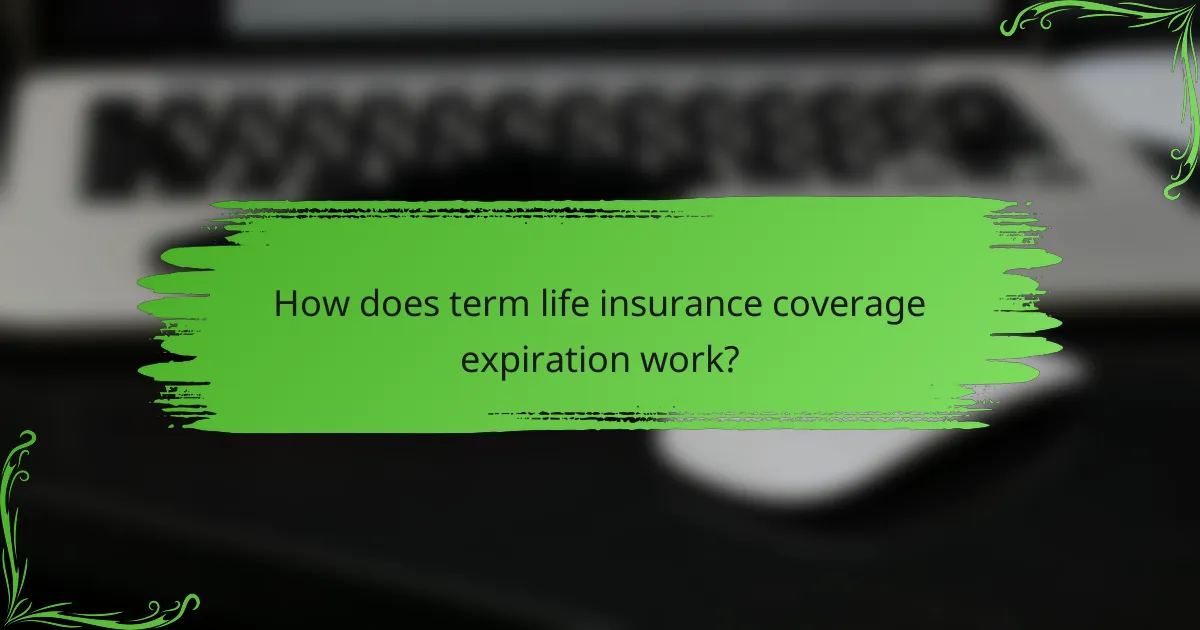Term life insurance provides coverage for a specified period, typically between 10 to 30 years, after which the policy may expire. Upon expiration, policyholders have options to renew, convert to permanent insurance, or allow the policy to lapse, depending on their individual circumstances. Renewal rates often increase with age and health changes, reflecting the heightened risk insurers face as policyholders grow older. Additionally, underwriting risks play a crucial role in determining premiums and eligibility, as they evaluate the insured’s health and lifestyle factors.

How does term life insurance coverage expiration work?
Term life insurance coverage expiration occurs when the policy term ends, typically ranging from 10 to 30 years. At this point, the insured may need to renew the policy, convert it to permanent insurance, or let it lapse, depending on their needs and circumstances.
Standard coverage duration
Term life insurance policies usually offer coverage durations of 10, 15, 20, or 30 years. The choice of duration affects the premium costs and the length of time your beneficiaries will receive benefits if you pass away during the term. Shorter terms generally have lower premiums, while longer terms provide extended coverage but at a higher cost.
Impact of age on expiration
As policyholders age, the likelihood of health issues increases, which can affect renewal options after expiration. Many insurers will reassess the risk based on the insured’s age and health status at the time of renewal, potentially leading to higher premiums or denial of coverage. It’s crucial to evaluate your health and financial situation as you approach the end of your term.
Policy renewal options
Upon expiration, most term life insurance policies offer renewal options, allowing you to extend coverage without undergoing a new medical exam. However, premiums may increase significantly based on your current age and health. Alternatively, some policies allow conversion to a permanent life insurance policy, which can be beneficial if you want lifelong coverage.

What are the renewal rates for term life insurance?
Renewal rates for term life insurance can vary significantly based on several factors, including the insurer, the policyholder’s age, and health status at the time of renewal. Typically, these rates increase as the insured ages, reflecting the higher risk associated with older age and potential health changes.
Average renewal rates in the UK
In the UK, renewal rates for term life insurance generally range from 5% to 15% higher than the initial premium, depending on the insurer and the individual’s health profile. For example, a policyholder who initially paid £30 per month might see their renewal premium rise to between £31.50 and £34.50. It’s advisable to compare offers from different insurers at renewal time to find the most competitive rates.
Factors affecting renewal rates
Several factors influence renewal rates for term life insurance, including the insured’s age, health changes, and lifestyle choices. As individuals age, the risk of health issues increases, leading to higher premiums. Additionally, if a policyholder develops a serious health condition during the term, this can significantly impact renewal costs.
Other considerations include the insurer’s pricing strategy and market conditions. Some insurers may offer more favorable renewal rates to retain customers, while others may increase rates more aggressively. It’s essential for policyholders to review their options and negotiate if possible, as loyalty does not always guarantee the best rates.

What underwriting risks should you consider?
Underwriting risks are critical factors that can influence your term life insurance premiums and eligibility. These risks assess your health, lifestyle, and other personal characteristics to determine how likely you are to make a claim.
Health-related underwriting risks
Health-related underwriting risks include any pre-existing medical conditions, family health history, and current health status. Insurers often require a medical examination to evaluate your health, which can impact your premium rates significantly.
Common health issues that may raise concerns include heart disease, diabetes, and obesity. For instance, individuals with chronic conditions may face higher premiums or limited coverage options.
Lifestyle factors impacting underwriting
Lifestyle factors such as smoking, alcohol consumption, and physical activity levels play a significant role in underwriting decisions. Smokers typically pay much higher premiums compared to non-smokers due to the increased health risks associated with tobacco use.
Additionally, engaging in high-risk activities, such as extreme sports or hazardous occupations, can also affect your insurance rates. It’s advisable to disclose all relevant lifestyle details to avoid complications during the underwriting process.

How can you manage term life insurance renewal?
Managing term life insurance renewal involves understanding your options and taking proactive steps to secure favorable terms. You can often negotiate better rates or switch providers to ensure you maintain adequate coverage without excessive costs.
Strategies for lower renewal rates
To achieve lower renewal rates, consider improving your health before the renewal period. Quitting smoking, maintaining a healthy weight, and managing chronic conditions can lead to better underwriting outcomes. Additionally, opting for a longer-term policy initially may lock in lower rates for a longer duration.
Another strategy is to review your coverage needs regularly. If your financial situation has changed, you might not need as much coverage, allowing you to adjust your policy accordingly. Always communicate with your insurer about any changes in your health or lifestyle that could affect your rates.
Importance of shopping around
Shopping around for term life insurance is crucial during renewal time. Different insurers may offer varying rates based on their underwriting criteria, so comparing quotes can help you find the best deal. Utilize online comparison tools or consult with an insurance broker to streamline this process.
Be mindful of the timing when you shop around. Start your search a few months before your policy expires to allow ample time for evaluation and decision-making. This proactive approach can lead to significant savings and ensure you secure the best possible coverage for your needs.

What are the alternatives to term life insurance?
Alternatives to term life insurance include whole life insurance and universal life insurance, both of which provide lifelong coverage and can accumulate cash value. These options may suit individuals seeking long-term financial security and investment opportunities.
Whole life insurance overview
Whole life insurance offers coverage for the insured’s entire life, as long as premiums are paid. This type of policy typically includes a savings component that builds cash value over time, which can be borrowed against or withdrawn.
Premiums for whole life insurance are generally higher than those for term policies, often remaining level throughout the policyholder’s life. This stability can be beneficial for long-term financial planning, but the initial cost may be a barrier for some.
Universal life insurance features
Universal life insurance provides flexible premiums and death benefits, allowing policyholders to adjust their coverage as their financial needs change. This type of policy also accumulates cash value, which earns interest based on market performance.
One key advantage of universal life insurance is the ability to modify premium payments and death benefits, offering adaptability. However, policyholders should be aware of potential fees and the impact of market fluctuations on cash value growth.

What trends are emerging in term life insurance?
Emerging trends in term life insurance reflect significant changes in technology, consumer behavior, and market dynamics. Insurers are adapting to these shifts by enhancing underwriting processes and tailoring products to meet evolving consumer needs.
Impact of technology on underwriting
Technology is revolutionizing the underwriting process in term life insurance by enabling faster and more accurate assessments of risk. Insurers are increasingly using data analytics, artificial intelligence, and machine learning to evaluate applicants’ health and lifestyle factors more efficiently.
This shift allows for streamlined applications, often reducing approval times to a matter of minutes instead of days. However, it also raises concerns about data privacy and the potential for algorithmic bias, which consumers should be aware of when applying for coverage.
Shifts in consumer preferences
Consumer preferences in term life insurance are shifting towards more flexible and customizable policies. Many individuals are seeking coverage that can adapt to their changing life circumstances, such as marriage, parenthood, or career changes.
Additionally, there is a growing demand for online purchasing options and simplified products that do not require extensive medical exams. Insurers are responding by offering no-exam policies and digital platforms that facilitate easier access to information and purchasing processes.


